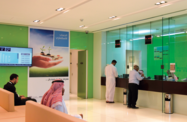Saudi Arabia’s banking sector is on track to see its first merger in nearly two decades amid efforts to expand credit growth into targeted sectors, which comes as lenders across the board are poised to benefit from higher interest margins.

On October 4 Saudi British Bank (SABB) and Alawwal Bank announced their boards had approved a binding agreement to merge the two institutions, creating what will be Saudi Arabia’s third-largest bank.
Alawwal’s assets will be transferred to SABB under the agreement, giving the consolidated bank assets of more than $70bn and a market capitalisation of $17.2bn.
The merger will narrow an already tight domestic market – the sector currently comprises 13 banks, a lower figure than in many neighbouring countries with smaller economies – and will be the first since the Saudi American Bank and United Saudi Bank joined forces in 1999.
While the $5bn merger, which is not expected to be completed until early next year, will likely impact the immediate earnings of the consolidated bank, and possibly draw down revenue returns for the broader sector, any adverse effect will likely prove short term in nature.
In a statement issued on October 10, global credit ratings agency Moody’s said that, on completion, the merger would provide increased diversification and lending opportunities in a slow economic environment, as well as create medium-term potential for revenue and cost synergies. Furthermore, it expects the integration risks and costs associated with absorbing Alawwal’s loan portfolio, which has a higher proportion of non-performing loans (NPLs), to be offset by the benefits of the merger.
The new bank plans to target sectors with high potential for credit growth: small and medium-sized enterprises and the tech market, along with mortgage market expansion, are key areas.
Non-oil sector spurs banking growth
The banking industry more broadly is looking toward higher earnings, following the Kingdom’s return to positive economic growth and increased credit demand in the non-oil and consumer sectors.
Alongside a resumption of greater state spending, credit demand has expanded across key non-oil sectors in 2018. The most recent report from the Saudi Arabian Monetary Authority (SAMA) showed particularly strong year-on-year credit growth in the second quarter in mining (40.8%), transport and telecoms (9.5%), and manufacturing (7.8%).
Although commercial bank profits dipped that quarter, easing from SR12.2bn ($3.3bn) in the first quarter to SR11.9bn ($3.2bn), total bank lending to the private sector accelerated, with growth posted every month this year barring a seasonal dip in June due to Ramadan.
In July the IMF reported it expects Saudi credit and deposit growth to continue to strengthen in the short to medium term.
This outlook was mirrored by international ratings agency Standard & Poor’s (S&P), which in an October 1 report also forecasted Saudi GDP to expand by an average of 2% per year through to 2021, reversing the contraction seen in 2017.
According to S&P, stronger economic growth in 2019, along with additional interest rate increases and higher state spending, will help banks in Saudi Arabia and other Gulf states boost earnings.
Interest rate hikes to bolster banking profits, but may affect demand for loans
Along with moderate credit growth, wider interest margins should bolster earnings for some Saudi lenders in the latter part of 2018 and into 2019.
Net interest margins in the Kingdom have been on an expansionary trend since 2016, rising from an average of 2.5% that year to 3.1% by mid-2018, aided in part by a low average cost of funding – which, at 1%, stands as the lowest in the GCC region. The trickle down of recent monetary tightening by the US Federal Reserve could help to accelerate this effect, according to Moody’s.
Tracking moves by the US Federal Reserve, SAMA has increased its own policy rate three times in 2018, the latest being a 2.25-basis-point rise on September 26. Alongside this, the three-month Saudi interbank offered rate, another key benchmark, was pushed up to 2.7% in October, its highest level in a decade.
Banks with a large share of non-interest-bearing deposits and rate-variable corporate loans are best placed to benefit from any re-pricing, though the sector as a whole is also in good standing, with a net loan-to-deposit ratio of 84% as of mid-2018, according to financial news site CPI Financial.
Nevertheless, interest rate hikes could, over the longer term, weigh on demand for credit and the ability to service existing debt, particularly if the US Federal Reserve continues to pursue a tighter monetary policy. Analysts will therefore be keeping a close eye on NPLs in highly leveraged, cyclical industries such as construction and commerce.


